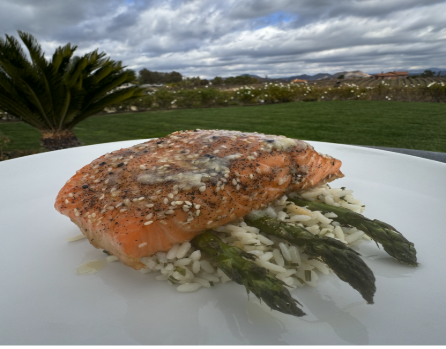Food and wine pairing is a culinary tradition that has been practiced for many years across cultures. With a wide selection of wines and foods, knowing how to pair them well requires a certain level of skill. However, you can ease into the world of wine pairing by first understanding the basics.

What Is Wine Pairing?
Wine pairing is a process of combining dishes with wines that perfectly complement the flavors for an elevated dining experience. The main concept is that some characteristics of both the food and wine, such as flavor and texture, work well together to enhance your enjoyment of each element.
The Basics of Wine Pairing
When it comes to wines, the options are endless, from rich reds to light-bodied whites. As a beginner, finding the perfect wines to pair with your favorite dishes can seem intimidating. Here are two basic wine-pairing rules to help you get started:
- Match the flavors: Consider matching the wine with the most notable elements of your dish, such as sauce or seasoning. For example, light citrus-based sauces can be paired with white wines such as chardonnay or sauvignon blanc.
- Match the weight: The weight of a wine refers to how heavy or light it feels on the palate. You will want to pair light meals such as poultry or fish with delicate light-bodied wines. A rich, full-bodied red wine will be the best option for heavier dishes with red meat.
The Flavor Profiles and Types of Wine
There are a number of elements that come together to produce the flavor profiles of wine. Here are some of the prominent flavor profiles in different types of wine:
- Sweetness: During the wine-making process, most of the shoulder content is absorbed by yeast. The remaining sugar, otherwise known as residual sugar, determines the sweetness of the wine. A wine such as riesling is usually referred to as sweet due to its taste.
- Acidity: The acidity in wine is the element that is responsible for its fresh, tart and sour taste. Acidity is an essential trait found in all wines that preserves the wine longer. Wines with high acidity levels such as sauvignon blanc, feature a crisp and sharp taste.
- Body: The body of a wine is determined by its weight, texture and richness. A light-bodied wine such as pinot noir will have a lean and delicate mouth feel. On the other hand, full-bodied wines such as shiraz or chardonnay will feel thick and viscous in the mouth.
- Tannins: Wine tannins are extracted from grape skin, seeds, stems and wood barrels used in the production process. Tannins are responsible for the dry and bitter sensation a wine leaves in your mouth. You will find that wines such as merlot are medium-bodied. They have moderate acidity and alcohol content, as well as balanced tannins.
The Flavor Profiles of Food
There are six main food flavor profiles you can explore to develop great wine and food pairings:
- Salt: Salty foods pair well with acidic and sparkling wine to balance out the sweetness and bring out the fruitiness of the wine.
- Acid: Acidic foods such as salads or seafood pair well with wines that have higher acidity.
- Bitter: When it comes to bitter food, avoid pairing them with bitter wines. Dishes with this flavor profile are enhanced by acidic or sweet wine.
- Fat: Fatty foods pair well with medium-bodied wines like merlot. The bitter taste of the tannins balances out the fat and brings out its flavors.
- Sweet: Sweet foods such as desserts pair well with wines that have higher levels of sweetness.
- Spice: Spicy foods can enhance the bitterness or acidity of a wine. It is best to pair spicy dishes with a sweet wine to calm the burning sensation on your tongue.
A good rule of thumb is to pair red wines with red meats and fatty, hearty dishes. White wines are best with lighter flavors, perfect for fish and poultry.
So, what makes a good wine pairing? Consider this your cheat sheet, or your wine pairing guide. It’s tough to remember what goes with what—especially because there are dozens of great wines out there—so here are some tried and true wine pairings.
- Chardonnay and Salmon
Chardonnay is a great wine pairing with Salmon. A dry, medium-bodied Chardonnay pairs great with light meats like fish and other seafood in flavorful sauces.

- Cabernet and Red Meat
A rich wine needs a rich dish. That’s why Cabernet and red meat pair so well together
- Pinot Noir and Earthy Flavors
Pair a deep Pinot Noir with earthy, savory flavors like mushroom dishes or hearty pizzas.

- Pinot Grigio and Seafood
Pinot Grigio and light seafood dishes work perfectly together because of their light, delicate flavors.
- Sauvignon Blanc and Tart Flavors
Sip a piquant Sauvignon Blanc and pair it with a tart dressing or sauce for a flavorful zing.
- Rosé and Cheesy Dishes
When it comes to cheese, Rosé is your go-to because it has the acidity of white wine while still maintaining the fruity notes of red.

- Sparkling Wine and Salty Flavors
Sparkling wines usually have notes of sweetness in them,
perfect for complementing salty foods
- Riesling and Sweet, Spicy Flavors
Lightly sweet, many Rieslings help balance spicy dishes while complementing sweetness as well.
- Syrah and Spiced Dishes
For heavily spiced dishes, choose Syrah to help finish out the flavor of your dish.
- Zinfandel and Rich Plates
The richness of Zinfandel complements the richness of foods like pâtés, mousses, and terrines.
Trust your palate and go with what you like. Just because a wine and a food are known to go together doesn’t mean you’ll want that pairing.
For a fun way to discover your own preferences and those of your friends, throw a tasting party with a few different dishes and two or three wines to taste with each dish. Take notes and compare them to see just how varied everyone’s palates can be. Have some fun with it and I hope to see you next week for more tips and tricks.